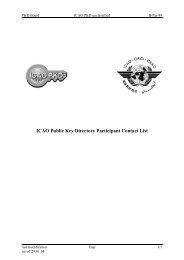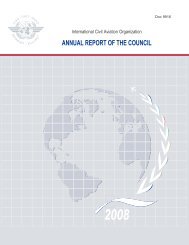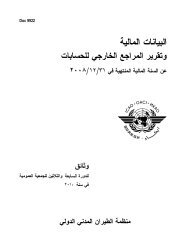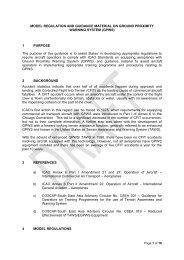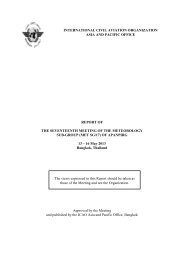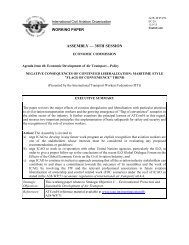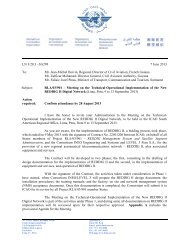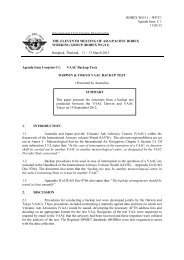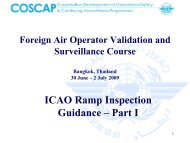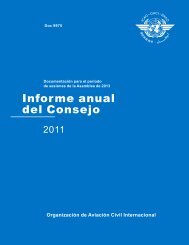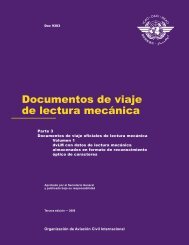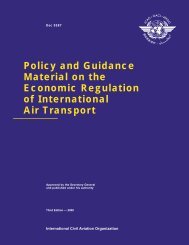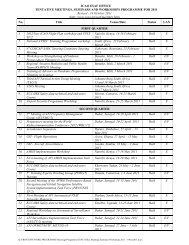afi met bulletins exchange (ambex) handbook - ICAO
afi met bulletins exchange (ambex) handbook - ICAO
afi met bulletins exchange (ambex) handbook - ICAO
Create successful ePaper yourself
Turn your PDF publications into a flip-book with our unique Google optimized e-Paper software.
Page 8 of 29<br />
Volcanic Ash Contingency Plan – AFI Region<br />
b) based on these forecasts and in cooperation (CDM) with aircraft operators and the adjacent ACCs, ACC<br />
measures should be devised and updated when necessary to ensure safety of flight operations.<br />
c) ensure a NOTAM is originated to define a danger area delineated cautiously so as to encompass a<br />
volume of airspace in accordance with the limited information available.<br />
d) ensure that reported differences between published information and observations (pilot reports, airborne<br />
measurements, etc.) are forwarded as soon as possible to the appropriate authorities to ensure its<br />
dissemination to all concerned.<br />
e) begin planning for the ongoing eruption phase in conjunction with the aircraft operators, the appropriate<br />
ACCs concerned.<br />
f) should significant reductions in intensity of volcanic activity take place during this phase and the<br />
airspace no longer is contaminated by volcanic ash, a NOTAMC cancelling the last active NOTAM<br />
shall be issued stating the cause for cancellation; new NOTAM/ASHTAM should be promulgated to<br />
update the situation. Otherwise, begin CDM planning for the ongoing eruption phase in conjunction<br />
with aircraft operators, the affected ACCs.<br />
4.3 Adjacent ACC Actions<br />
4.3.1 During the start of eruption phase adjacent ACCs should take the following actions:<br />
a) maintain close liaison with the originating ACC to design, implement and keep up to date ACC<br />
measures which will enable aircraft to ensure safety of flight operations.<br />
b) in the event that tactical measures additional to those issued by the appropriate ACC are required, the<br />
adjacent ACC should, in cooperation with the originating ACC and aircraft operators, impose such<br />
measures.<br />
c) maintain a running plot of the affected area.<br />
d) begin planning for the ongoing eruption phase in conjunction with the aircraft operators, the ACCs<br />
concerned.<br />
5. ONGOING ERUPTION PHASE<br />
5.1 The ongoing eruption phase commences with the issuance of the first VAA/VAG by the VAAC after<br />
completion of the start of eruption phase responses. The VAA/VAG will contain the current position of the volcanic<br />
cloud and forecasts of the expected vertical and horizontal extent of the volcanic ash cloud, and its expected movement,<br />
at six-hourly time-steps for the period T+0 to T+18 hours. When the volcanic ash cloud is expected to move<br />
considerably during a 6 hour period, VA SIGMETs for shorter periods should be produced.<br />
5.2 Volcanic cloud forecasts and/or VAA/VAGs may include (if available) quality indicators (e.g. accuracy,<br />
variability, etc.) and risk levels that can more easily be used in SRAs.<br />
5.3 Following the start of eruption phase, the VAA/VAG should be used to define airspace volumes encompassing<br />
the furthest extent of contamination predicted for that period. These volumes should be used to:<br />
a) publish NOTAM/ASHTAM indicating the extent of areas of volcanic ash contamination,;<br />
b) issue VA SIGMET warning of potential hazard from areas of volcanic ash contamination; and<br />
c) apply appropriate ACC measures.



